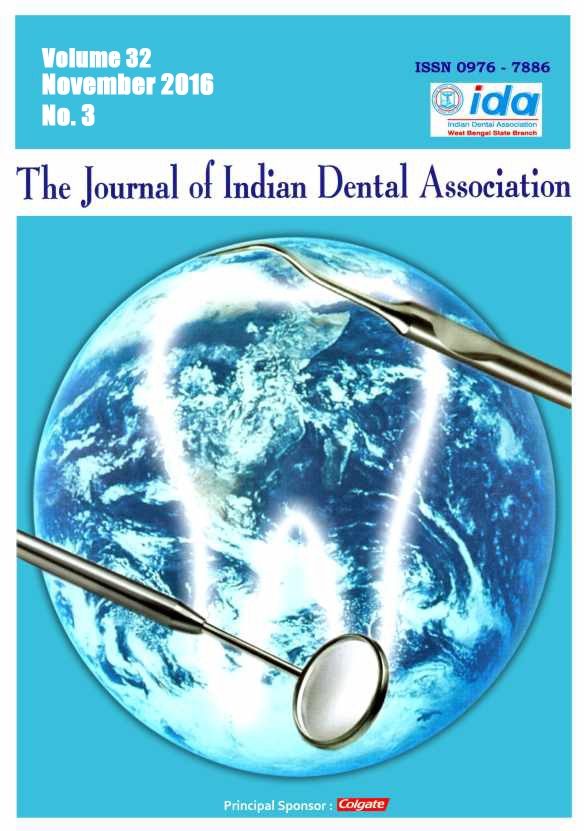Upcoming Events
1. Article Title.
2. Author Details.
3. Abstract.
4. Keywords.
5. Corresponding Author details.
November 2016
Volume : 32
No.: 3

Dr. Arka Swarnakar
Abstract: Amelogenesisimperfecta is a developmental disorder where there is defective enamel deposition and maturation. This leads to early loss of tooth structure. The roots remain unharmed. The use of magnets has been a boon in the field of dental science and are used to retain overdentures, maxillofacial prosthesis, and obturators. These magnets are attached with either any root structure or osseointegrated implants which transfer the occlusal load to the bone. This case report describes the use of a magnetic assembly in fabricating a mandibular overdenture on retained roots and a conventional maxillary complete denture. Magnetic assembly consists of magnet within the prosthesis and a keeper on the remaining tooth structure. The magnetic attachments did aid in providing support, stability, and retention.
Abstract: Most microbial ecosystems contain large numbers of genetically distinct microorganisms, and the human mouth is not different. The biofilm communities are complex and dynamic structures that accumulate through the sequential and ordered colonization of multiple oral bacteria. Oral biofilms are characterized by surface attachment, structural heterogeneity, complex interspecies interactions, and an extracellular matrix of polymeric substances, and are high-density micro-niches that differ dramatically from surrounding conditions. Here, it is an attempt to discuss the ecology of oral biofilm.
Dr. Sagar Kapse
Abstract: 1
Prof.(Dr.) Ravindra Rekhade,Dr. Jayashree Chakraborty,Dr. Debraj Sarkar
Abstract: Indirect bonding technique that helps in precise positioning of orthodontic brackets and reduces clinical time needed for bonding. The precise location of bracket placement on the teeth is a goal in order to individualize and optimize the treatment outcome. The article will present an overview of the techniques of indirect bonding. It helps the clinician to choose and analyze the indirect bonding technique.
Abstract: Hemifacial microsomia is a congenital anomaly of face caused due to interference with migration of neural crest cells and charecterized by lack of tissue on the affected side of face. The affected child suffers from gross disfiguration of face, functional disturbances, malocclusion and poor psychosocial acceptance. An early detection and management is therefore necessary which require a team approach by orthodontist, radiologist, oral surgeon, plastic surgeon and prosthodontist. In this article etiology, clinical features and treatment outline of Hemifacial microsomia is discussed along with two case reports.
Dr. Tanmay Biswas,Dr. Anindita Majumder,Dr. (Prof) T. K. Giri,Dr. (Prof) S. Mukharjee
Abstract: Resin bonded bridges are a minimally invasive option for replacing missing teeth. The minimal-preparation, resin retained adhesive bridge may be considered to be an ideal choice of fixed prosthesis to replace a single missing tooth, especially in the anterior region. Many dental practitioners do not use adhesive bridges because of concerns over high failure rates. This article highlights advantages, disadvantages, types of framework and bridge designs and clinical procedure which may improve outcome, with a special mention of all ceramic resin bonded bridges.
Abstract: Ethics is a cornerstone of dental research, and, for that matter, any research. Authorship in scientific research is an important issue which requires considerable discussion and debate. The pressure to publish is well-established in the university community. Faculty member's performance and promotion are judged by the number of published articles in academic or scholarly journals. Most of the dental schools or universities in India do not have an ethics committee. Ethical issues like informed consent and ethics committee clearance are being taken for granted. That is, these words are mentioned in the manuscript or research paper, without the actual consent or clearance being given. The authors submit that these infringements may be made knowingly and/or unknowingly. The misconduct in research and publication not only affects other authors, but reviewers and editors, as well. However, the worst sufferer is the patient.












